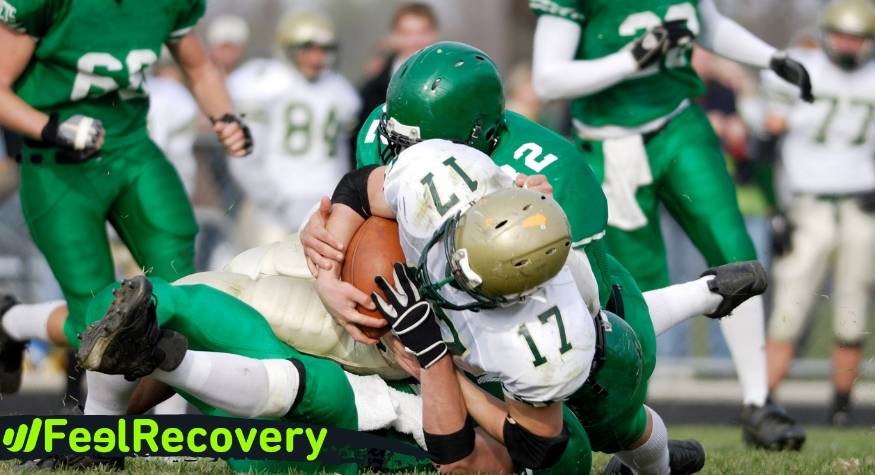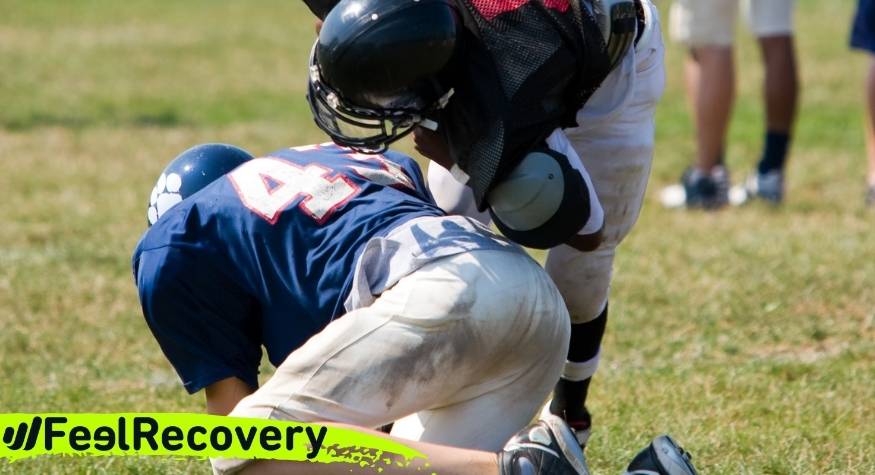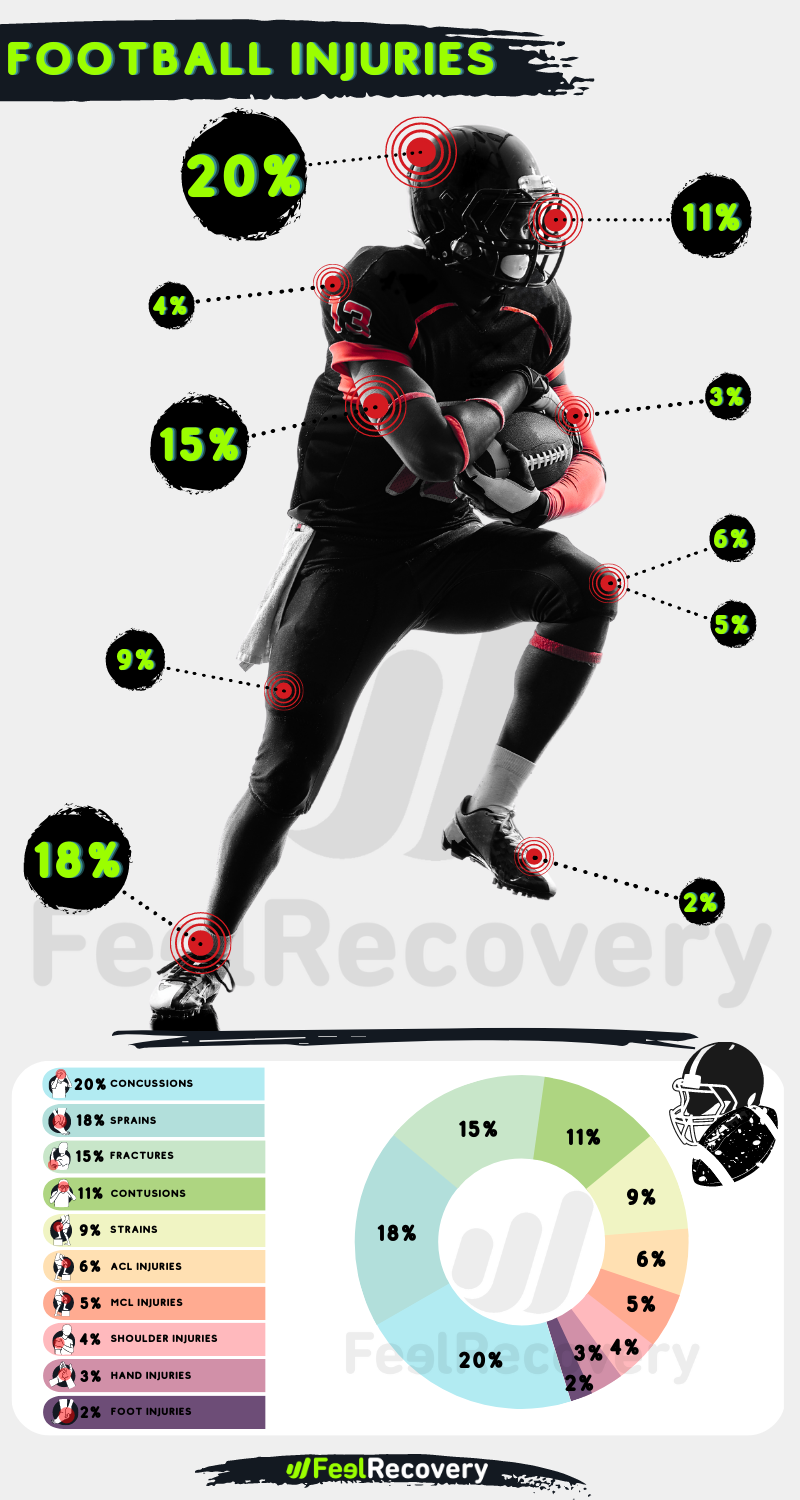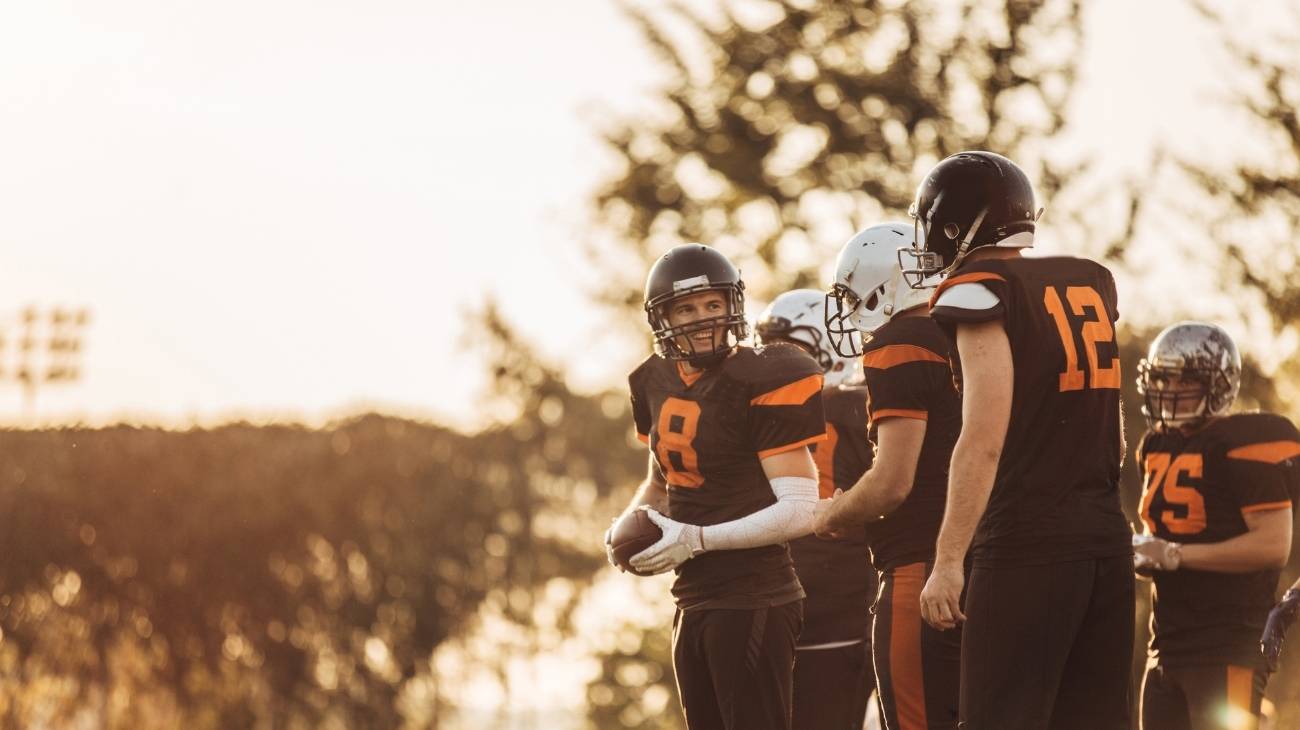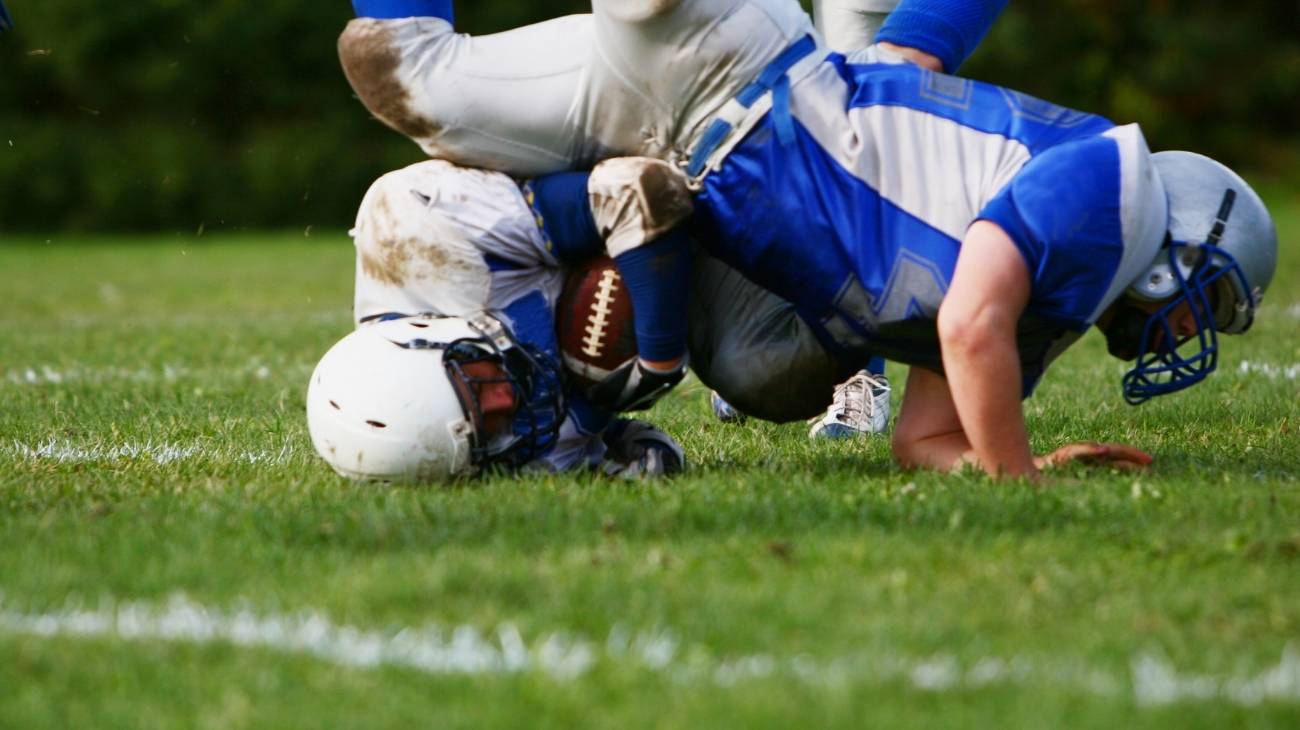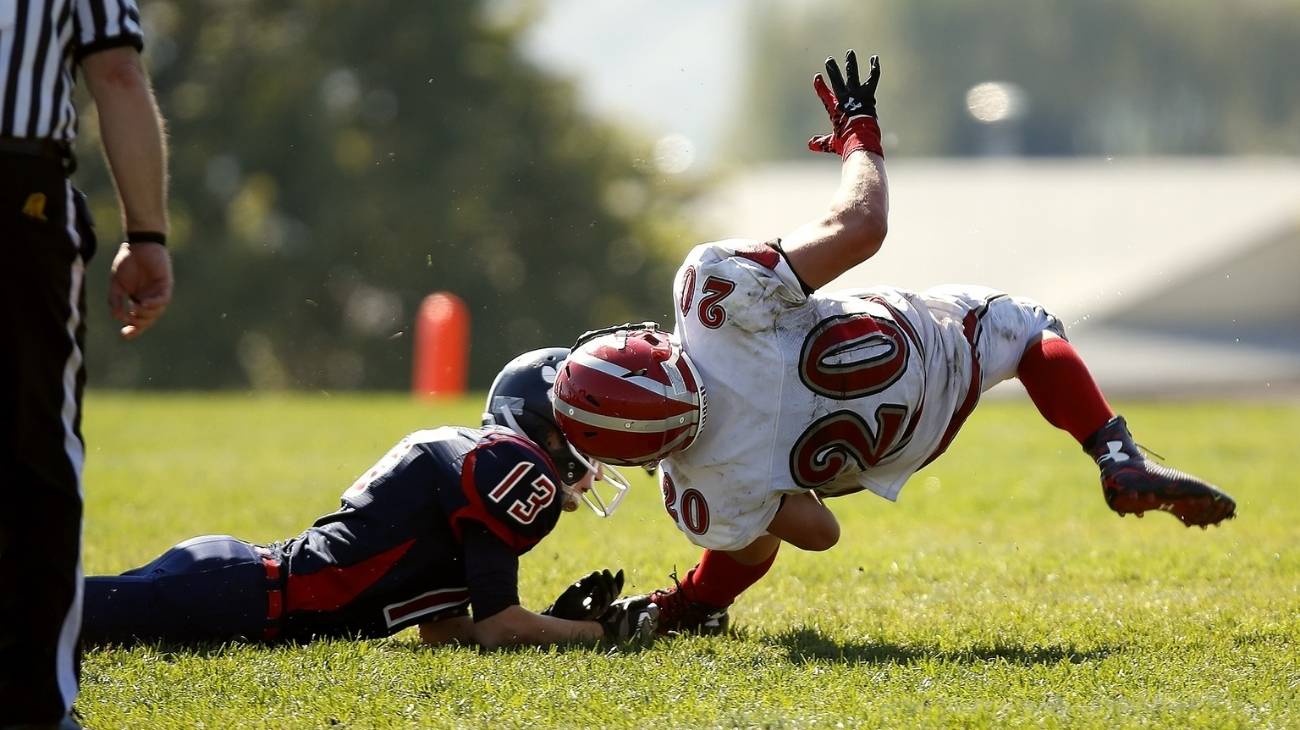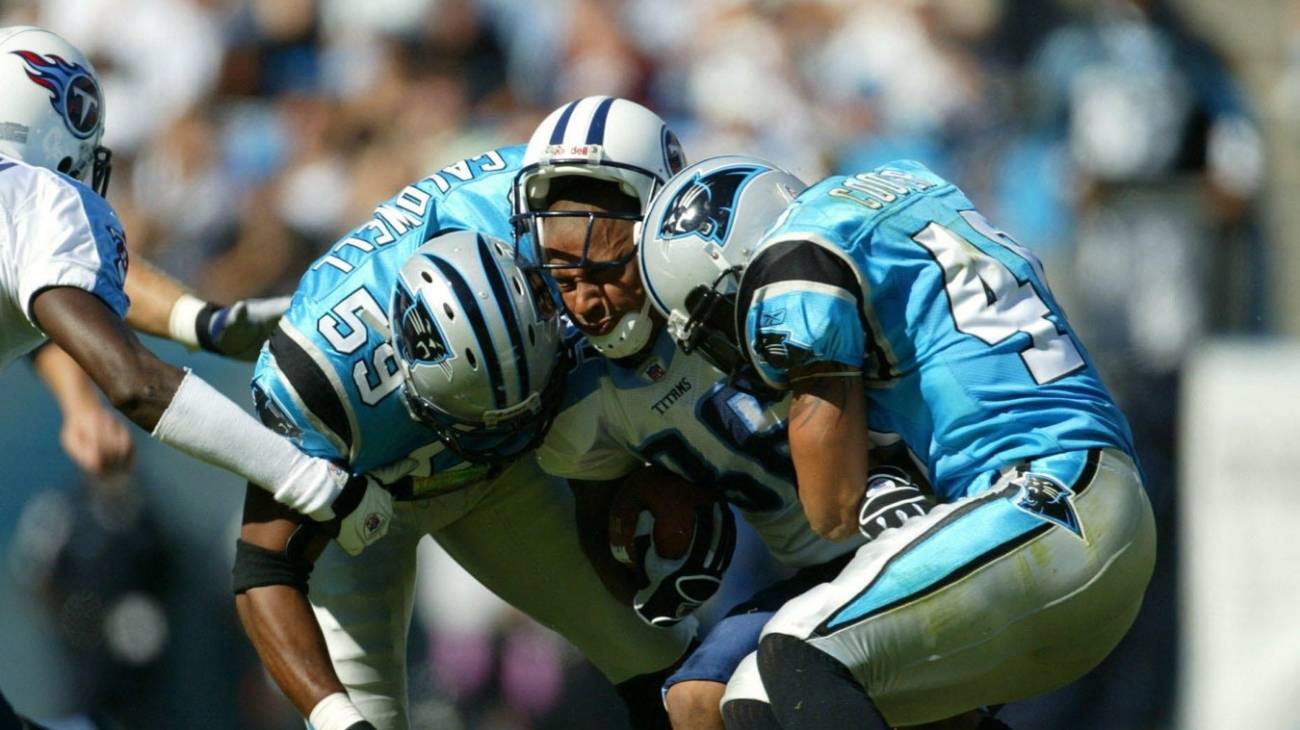Football is one of the most impactful team sports in the United States and Canada. The National Football League (NFL) and the Canadian Football League (CFL) estimate that, for every 1,000 hours of training and games, there are about 40 injuries to each player in their leagues. If you want to be a professional player of this sport or play it as an amateur, you should be aware of all possible injuries in order to avoid them.
During this article we will review the types of injuries in football players by body parts, taking into account that the joints are the most affected. We will tell you what you should do to prevent injuries as a professional or amateur player, and you will learn how to use the PRICE therapy as a form of first aid.
What are the most common types of injuries when playing football?
If we were to group the types of injuries in football, we would do it according to trauma and collisions in the games, also the injuries would be classified by wear and tear, fatigue in the tissues and bone structures. Check this list of the most frequent injuries in football.
Head and neck injuries
Although the head and neck are always well protected, they tend to be quite sensitive to injuries. Among the most common we can identify the following:
- Hyperlordosis: It is the excessive curvature of the vertebrae of the spine, the curvatures are more frequent in the lumbar and cervical area, so when it occurs in the upper area it triggers an unbearable headache and constant discomfort in the neck. Although age is the main culprit, blows to the head increase the likelihood of this injury.
- Herniated disc: This injury also occurs due to repeated and severe blows from behind, but it has been proven that wear and tear in body movement also affects. A herniation is the displacement of the vertebral disc and its deformation when the injury is advanced. If treated in time, only rest will be necessary.
- Cervical sprain: It is also called "whiplash" and is the tearing of one or more ligaments in the neck by a trauma from behind or from the side. Only by means of an X-ray can it be ruled out that there are no fractures because the pain and stiffness are intense after the injury. Rest and relaxants are important to obtain relief.
- Cerebral contusions: This is damage to the functioning of the brain due to a strong blow. And although today's helmets are made of highly resistant plastic, the force of the blows is enough to cause damage to the brain structure. The NFL estimates that 90% of players will have a concussion by the end of each season.
- Chronic traumatic encephalopathy: These are intense and repeated pains caused by the player's constant collisions. It is not something eventual, but a consequence of blows in each match that ends up affecting the functioning of the brain. The only way to diagnose it is through an autopsy, so it is considered a degenerative disease.
Shoulder injuries
The shoulders are one of the most commonly injured joints during a football season. Among the most common that we can identify are:
- Dislocations: The main cause is blows received on the field. This injury occurs when the arm bone is displaced towards the anterior part and this can be partial or total. In both cases, immobilization of the arm is required after repositioning it. Physiotherapy is then recommended.
- Tendinitis: Again, the blows and the wear and tear of tissues are the reasons why a tendon is irritated. Football is more demanding with the rotator cuff tendon and the biceps tendon. After irritation and mild pain, comes the rupture in some of the fibers and then the total rupture of this tissue that joins the muscles to the bones.
- SLAP lesion: It is the insertion of the tendon in the biceps brachii. One of the reasons it occurs is because of the repeated motion of throwing the ball, so it is a common injury in offensive line players. SLAP stands for Superior Labrum Anterior to Posterior, and this injury affects the labrum, a fibrocartilaginous component that creates stability.
- Acromioclavicular injury: This is a complex injury that can involve sprains and fractures in the clavicle area. It is generated by the fall of the player with the arm extended, perhaps in an attempt to cushion the blow against the ground. In the event of a fall with these characteristics, it is recommended to perform an immediate examination.
- Fractures: As expected, the vast majority of shoulder fractures occur in the clavicle, despite all the protection that players have. The clavicle is a fragile bone, located horizontally so any lateral blow will affect it. Sometimes it is not necessary to go to surgery, as long as the fracture is in the form of a fissure.
Knee injuries
The knee is usually the ultimate headache for football players and any sport in general. The most common injuries are the following:
- Bursitis: It is an injury present even in young and strong players, but that allow an overload of tension in the knee until there is an excess of synovial liquid in the joint, this excess irritates the bursa that is a cushion that cushions the fraction between the internal components of the knee.
- Patellofemoral syndrome: It is generated by inadequate alignment of the knee while the body receives strong body pressure. During flexions, it increases the probability of an imbalance in the knee that causes an irregular movement. The injury accounts for 20% of the causes of NFL injuries.
- Friction of the iliotibial band: It is a constant friction in the tensor fascia lata, called iliotibial band. It is no longer from hard blows received, this time it is an abnormality in the players' gait when jogging and running. It is likely that, in the NCAA, which encompasses college teams, the presence of this injury is stronger.
- Traction apophysis: It is the inflammation of the center where the muscles and tendons connect, this is the apophyseal center of secondary ossification. It is a disease that alters the functioning of both tissues until they force the tension to the bone structure. It is originated by the intense and repeated contraction of the quadriceps. It begins as an irritation of this center and then gives way to tears.
- Sprains: It is a classic and common injury in football. It is due to the tearing of ligaments after falls to the ground or due to muscle tension overload. This overload occurs when the body rotates and changes direction while the foot remains fixed on the ground. There are three types of knee sprains, in the third one it is necessary to go to the operating room to repair the damage.
Other types of injuries
In addition to the aforementioned areas, we can identify other injuries in various parts of the body. The most common are the following:
- Stress fracture: It can occur in any bone structure of the body, but as football is a sport of high intensity in the lower extremities, most cases tend to be concentrated there. When the physical demand exceeds the muscular capacity, the body reacts by distributing the load in other tissues and in the bones. The main risk factor is excessive training without sufficient rest.
- Pubalgia: It is an imbalance in the functioning of the hip that leaves an irritation in the tendons and muscle fibers in the pubic area. It is an ailment caused by constant running, stopping, starting and kicking the ball. It is a disease caused by wear and tear and not by strong blows, it always starts with signs such as mild pain and discomfort when walking.
- Plantar fasciitis: This is a discomfort that starts in the heel of the foot and can extend to the metatarsals. It is the inflammation of the fascia, a tissue that protects the sole of the foot from jumps and strides when jogging or running. Although it is a resistant tissue because it supports more than the original weight of the person, sometimes it is injured by the high demand of sports in which the tension in the feet is high.
- Bone avulsions: It is the increase of the bony structure, frequently in the joints, which generates an irregular pressure that alters its functioning. It starts with the insertion of tendon and muscle units. The bad news is that it is a malady in runners and in positions where maximum musculoskeletal tension is required.
- Ankle sprains: It is common for players' body weight and change of direction to be a frequent injury in football. The ankle is a small but resistant joint; however, it can be injured if the pressure exerted exceeds its capacity to withstand all that action. Keep in mind that there should always be a proper warm-up to get the joints ready.
Best products for football injury recovery
Bestseller
-
2 Calf Compression Sleeve (Black/Gray)
$19.95 -
2 Calf Compression Sleeve (Green/Navy)
$19.95 -
2 Calf Compression Sleeve (Pink/Bordeaux)
$19.95 -
2 Knee Compression Sleeve (Black/Gray)
$19.95 -
2 Knee Compression Sleeve (Green/Navy)
$19.95 -
2 Knee Compression Sleeve (Pink/Bordeaux)
$19.95 -
2 Thigh Compression Sleeve (Black/Gray)
$19.95 -
2 Thigh Compression Sleeve (Green/Navy)
$19.95 -
2 Thigh Compression Sleeve (Pink/Bordeaux)
$19.95 -
Acupressure Mat and Pillow (Black/Gray)
$49.95 -
Acupressure Mat and Pillow (Green/Navy)
$49.95 -
Acupressure Mat and Pillow (Pink/Bordeaux)
$49.95 -
Acupressure Pillow (Black/Gray)
$29.46 -
Acupressure Pillow (Green/Navy)
$29.46 -
Acupressure Pillow (Pink/Bordeaux)
$29.46 -
Back Support Belt (Black)
$34.95 -
Back Support Belt (Green)
$34.95 -
Back Support Belt (Pink)
$34.95 -
Foot Massage Roller for Plantar Fasciitis (Black)
$19.95 -
Foot Massage Roller for Plantar Fasciitis (Green)
$19.95 -
Foot Massage Roller for Plantar Fasciitis (Pink)
$19.95 -
Gel Eye Mask for Puffy Eyes (Gold/Black)
$11.95 -
Gel Eye Mask for Puffy Eyes (Orange/Pink)
$11.95 -
Gel Eye Mask for Puffy Eyes (Purple/Turquoise)
$11.95 -
High Density Foam Roller for Muscle (Black/Gray)
$24.95 -
High Density Foam Roller for Muscle (Green/Navy)
$24.95 -
High Density Foam Roller for Muscle (Pink/Bordeaux)
$24.95 -
Ice Massage Roller Ball (Black)
$39.95 -
Ice Massage Roller Ball (Green)
$39.95 -
Ice Massage Roller Ball (Pink)
$39.95 -
Microwave Heating Pad for Back Pain Relief (Extra Large) (Hearts)
$29.95 -
Microwave Heating Pad for Back Pain Relief (Extra Large) (Oxford)
$29.95 -
Microwave Heating Pad for Back Pain Relief (Extra Large) (Sport)
$29.95 -
Microwave Heating Pad for Neck & Shoulder Pain Relief (Hearts)
$24.95 -
Microwave Heating Pad for Neck & Shoulder Pain Relief (Oxford)
$24.95 -
Microwave Heating Pad for Neck & Shoulder Pain Relief (Sport)
$24.95 -
Microwave Heating Pad for Neck Pain Relief (Hearts)
$19.95 -
Microwave Heating Pad for Neck Pain Relief (Oxford)
$19.95 -
Microwave Heating Pad for Neck Pain Relief (Sport)
$19.95 -
Pack 2 In 1 Foam Roller High + Soft Density (Black/Gray)
$29.95 -
Pack 2 In 1 Foam Roller High + Soft Density (Green/Navy)
$29.95 -
Pack 2 In 1 Foam Roller High + Soft Density (Pink/Bordeaux)
$29.95 -
Shoulder Support Brace (Black)
$24.95 -
Shoulder Support Brace (Green)
$24.95 -
Shoulder Support Brace (Pink)
$24.95 -
Soft Density Foam Roller for Recovery (Black)
$24.95 -
Soft Density Foam Roller for Recovery (Green)
$24.95 -
Soft Density Foam Roller for Recovery (Pink)
$24.95 -
Trigger Point Massage Stick (Black)
$14.95 -
Trigger Point Massage Stick (Green)
$14.95 -
Trigger Point Massage Stick (Pink)
$14.95
How to prevent injuries when practicing football?
Although in such a violent sport it is difficult to remain 100% free of ailments, there are some methods to prevent them and reduce the probability of suffering them as much as possible. Among the most common and effective are:
- Perform a good warm-up: Every good athlete should know that the body needs to be well prepared to withstand the demands of football. To avoid warming up the body before training or before a game is to sentence an injury before it occurs. Warming up well will make the body withstand the intensity of the physical effort.
- Cool down well: It is not a matter of taking a shower or lying down after training, it is to maintain a minimum physical activity for a few minutes so that the body returns to its calm state. Blood pressure is regulated, heart rate and lung activity are controlled. In addition, the muscles are prepared for a new workout.
- Respect rest: Whenever you finish a workout or a game, ideally you should allow the body to recover completely. Maintain a healthy routine that allows you to give your body mobility without exhausting it. This recommendation applies best when you try to train without control and without rest. And if you suffered an injury, always try to allow time for recovery.
- Good nutrition and hydration: More than eating any amount of food, is to plan a menu that allows you to consume proteins and carbohydrates to the extent of what your body needs. Muscles need these nutrients to avoid injury and perform better. In turn, water will circulate these nutrients better in the body.
- Staying in shape: Certainly, football players have a certain build and altitude, so they add a psychological component to their attacks. But it doesn't mean that the taller and sturdier you are, the better your performance will be. There are agile runners and strong runners, both are useful. All exercise should be based on your qualities.
- Know your limits: The best injury prevention is to know what are the qualities that each one has as a professional. Trying to hide a discomfort or injury will only lead to serious consequences. When recovery is not 100%, the probability of relapses increases. Pay attention to the indications of your specialist.
- Sports massage: Sports massages are helpful in the treatment and prevention of common football injuries. They can be used prior to sporting activity to prepare players, or afterwards to promote muscle relaxation and recovery.
- Use of heat/cold therapy: Also known as contrast therapy, this is basically the application of alternating heat and cold. It has excellent analgesic and anti-inflammatory properties and also helps to reduce fatigue. These virtues make it ideal for treating and preventing injuries.
- Use of compression garments: Compression garments (T-shirts, shorts, socks, sleeves...) have excellent benefits. Wearing them before, during and after football training and games reduces the risk of injury and generates greater endurance. In addition, they also promote recovery after physical activity according to some studies.
- Use of acupressure therapies: Acupressure therapies involve the application of pressure to specific points on the body. It is attributed with analgesic and muscle relaxation properties, among others. For this reason, it is used in the recovery and prevention of sports injuries such as those originating in football.
- Use of thermotherapy and cryotherapy: Thermotherapy promotes flexibility and circulation, relieves pain and reduces inflammation. Cryotherapy works as an analgesic and anti-inflammatory and reduces spasms. Both therapies are used to treat and prevent injuries.
- Use of good equipment: The football helmet, shoulder and chest protector, arm and rib protector, coccyx protector etc. Ideally, the player should wear protective gear such as helmets, shin guards, ankle guards, mouth guards, among others.
How to apply the RICE therapy to treat first aid injuries in football players
This method is well known in the sports world, also in football. But unlike other disciplines, here it is not recommended that the athlete himself applies the steps of the PRICE therapy.
PRICE is an update of the RICE therapy, as it was originally introduced in the late 1970s. This acronym stands for Protection, Rest, Ice, Compression and Elevation.
- Protection: Depending on the site of the injury, which is usually a joint, you can use an elastic bandage to cover the affected area and reduce possible movements that complicate the ailment. If it is a third-degree sprain or fracture, it is not advisable to touch the injury.
- Rest: This is the most important step and depends entirely on the player. The damaged cells will begin to regenerate only when relaxation begins and for that there must be a rest that means lowering the amount of possible movements. If it is a mild injury, the rest should not last more than three days, then you should seek support from a specialist.
- Ice: No matter what the affected area is, you should always apply ice with the help of a handkerchief or thermal bag, thus avoiding skin burns. The ice serves to lower the blood flow in the injury, this will help reduce pain, reduce inflammation and prevent the edema from expanding.
- Compression: Try to use a compressive garment such as knee, ankle and elbow pads as these have the precise tension that the body requires. If you must use an elastic bandage, try not to tighten it too much because you do not want to completely cut off the blood flow.
- Elevation: If it is an injury to the arms and legs, it is recommended to raise the affected limb on a pillow, this will help gravity to have an effect on the amount of blood that circulates. This step favors pain relief and swelling control, which should not exceed 72 hours.
References
- Saal, J. A. (1991). Common American football injuries. Sports medicine, 12, 132-147. https://link.springer.com/article/10.2165/00007256-199112020-00005
- Kelly, B. T., Barnes, R. P., Powell, J. W., & Warren, R. F. (2004). Shoulder injuries to quarterbacks in the national football league. The American journal of sports medicine, 32(2), 328-331. https://journals.sagepub.com/doi/abs/10.1177/0363546503261737
- Pellman, E. J., Viano, D. C., Casson, I. R., Arfken, C., & Powell, J. (2004). Concussion in professional football: Injuries involving 7 or more days out—Part 5. Neurosurgery, 55(5), 1100-1119. https://journals.lww.com/neurosurgery/Abstract/2004/11000/Concussion_in_Professional_Football__Injuries.14.aspx
- Bradley, J. P., Klimkiewicz, J. J., Rytel, M. J., & Powell, J. W. (2002). Anterior cruciate ligament injuries in the National Football League: epidemiology and current treatment trends among team physicians. Arthroscopy: The Journal of Arthroscopic & Related Surgery, 18(5), 502-509. https://www.sciencedirect.com/science/article/abs/pii/S0749806302348588
- Brophy, R. H., Wright, R. W., Powell, J. W., & Matava, M. J. (2010). Injuries to kickers in American football: the National Football League experience. The American journal of sports medicine, 38(6), 1166-1173. https://journals.sagepub.com/doi/abs/10.1177/0363546509357836
- Yang, J., Cheng, G., Zhang, Y., Covassin, T., Heiden, E. O., & Peek-Asa, C. (2014). Influence of symptoms of depression and anxiety on injury hazard among collegiate American football players. Research in sports medicine, 22(2), 147-160. https://www.tandfonline.com/doi/abs/10.1080/15438627.2014.881818
- Luke, A. C., Bergeron, M. F., & Roberts, W. O. (2007). Heat injury prevention practices in high school football. Clinical journal of sport medicine, 17(6), 488-493. https://journals.lww.com/cjsportsmed/Abstract/2007/11000/Heat_Injury_Prevention_Practices_in_High_School.9.aspx
- Gacek, M. (2015). Association between self-efficacy and dietary behaviours of American football players in the Polish Clubs in the light of dietary recommendations for athletes. Roczniki Państwowego Zakładu Higieny, 66(4). https://agro.icm.edu.pl/agro/element/bwmeta1.element.agro-4c51ea03-3e22-45c6-bf0d-3c214d929a81
- Abbey, E. L., Wright, C. J., & Kirkpatrick, C. M. (2017). Nutrition practices and knowledge among NCAA Division III football players. Journal of the International Society of Sports Nutrition, 14(1), 13. https://www.tandfonline.com/doi/full/10.1186/s12970-017-0170-2
- Smart, B. J., Haring, R. S., Asemota, A. O., Scott, J. W., Canner, J. K., Nejim, B. J., ... & Schneider, E. B. (2016). Tackling causes and costs of ED presentation for American football injuries: a population-level study. The American journal of emergency medicine, 34(7), 1198-1204. https://www.sciencedirect.com/science/article/abs/pii/S0735675716001649















































































